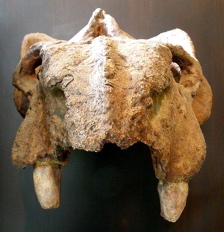 |
 |
 |
 |
 |
Produced
by the Population Genetics and Evolution class, Furman University |
||||
 |
 |
 |
 |
 |
Produced
by the Population Genetics and Evolution class, Furman University |
||||
 |
The
Triassic: Kannemeyeria |
 |
||
| Kannemeyeria
is a dicynodont, a large taxon of therapsid herbivores (Cloudsley-Thompson
2005). This creature grew to approximately three meters long and were
ox-sized (Wikipedia 2010). It had canine tusks, and elongated heads (Hammer,
Collinson, and Ryan 1990). Kannemeyeria had a skull that was
both strong and relatively light, due to the size of its eye sockets and
nasal cavity (Wikipedia 2010). Limb girdles also enabled the formation
of large bone plates that helped to support its substantial weight (Wikipedia
2010). Kannemeyeria inhabited a wide range areas, its fossils having been found in China, India, South Africa, and Argentina (Wikipedia 2010). A large beak and strong jaw muscles allowed it to tear up roots and strip vegetation (Cloudsley-Thompson 2005). The food was then chewed with toothless gums (Cloudsley-Thompson 2005). It also had a large abdomen, typical of herbivores consuming large quantities of vegetable material and suggesting a slow digestive process relative to later therapsids (Cloudsley-Thompson 2005). Kannemeyeria, along with many other forms of dicynodonts, were the first diverse and abundant taxon of herbivorous vertebrates (Cloudsley-Thompson 2005). Page by Lin-Lin Zhao |
 |
| Kannemeyeria skull. Photo from: www.macroevolution.net | |
|
Cloudsley-Thompson JL. 2005. Ecology and Behaviour of Mesozoic Reptiles. Springer-Verlag: Berlin. Accessed March 24, 2010. Hammer WR, Collinson JW, and Ryan WJ. 1990. A new Triassic vertebrate fauna from Antartica and its depositional setting. Antarctic Sci 2: 163-167. Wikipedia. 2010. Kannemeyeria. Accessed March 23, 2010. |